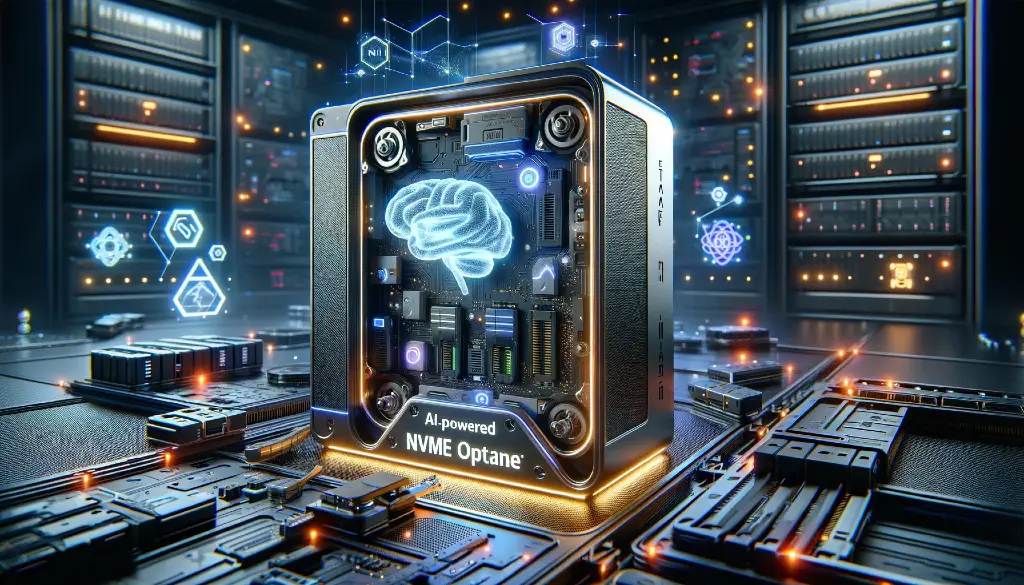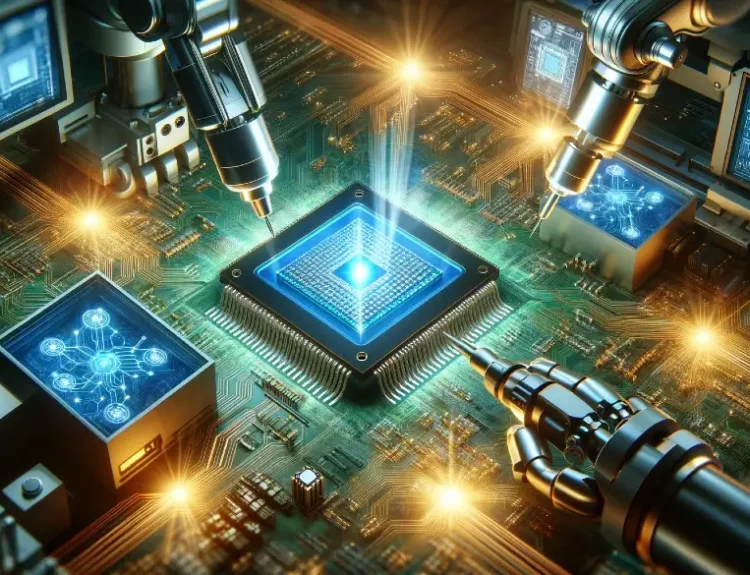Introduction
In a world where data reigns supreme and artificial intelligence fuels innovation at every turn, the backbone of intelligent systems lies in their ability to store and manage vast amounts of information. Picture this: a labyrinth of interconnected pathways, where bytes of data flow like streams of consciousness, shaping the very fabric of our digital existence.
Welcome to the intriguing realm of AI computer hard drives—where bytes become neurons and storage solutions serve as the synapses of intelligent systems. In this blog, we embark on a journey to unravel the enigma surrounding AI storage solutions, delving deep into the intricacies of neural network data storage, machine learning data management, and the evolving landscape of storage technologies tailored for artificial intelligence.
But why should you care about AI computer hard drives? Well, imagine a future where intelligent machines not only process data with lightning speed but also possess the foresight to anticipate our needs and desires. From autonomous vehicles navigating city streets to virtual assistants orchestrating our daily lives, the possibilities are as boundless as the data they consume.
Join us as we peel back the layers of complexity surrounding AI storage solutions and discover the key to unlocking the full potential of intelligent systems. Whether you’re a seasoned technologist, an aspiring AI enthusiast, or simply curious about the inner workings of the digital world, prepare to be captivated by the untold stories hidden within the bytes and bits of AI computer hard drives. The journey begins here—let’s dive in.
Understanding AI Computer Hard Drives
At the heart of every intelligent system lies its storage infrastructure—an intricate web of hardware and software designed to house and manage the deluge of data essential for AI operations. But what exactly are AI computer hard drives, and how do they differ from traditional storage solutions?
AI computer hard drives, also known as storage drives or storage devices, encompass a diverse range of technologies tailored to meet the unique demands of artificial intelligence workloads. Unlike conventional hard drives used in personal computers, AI storage solutions are optimized for handling massive datasets, complex computations, and high-throughput data access.
From solid-state drives (SSDs) to hard disk drives (HDDs) and emerging storage technologies such as non-volatile memory express (NVMe) and Optane, the landscape of AI computer hard drives is as varied as the applications they serve. Each storage technology offers its own set of advantages and trade-offs, ranging from speed and performance to cost and scalability.
Understanding the role of AI computer hard drives is essential for optimizing AI performance, minimizing latency, and ensuring efficient data management.
Exploring Artificial Intelligence Storage Solutions
Artificial intelligence storage solutions represent the cornerstone of intelligent systems, providing the foundation upon which machine learning models are trained, inference tasks are executed, and insights are derived from vast datasets. From neural network data storage to machine learning data management, the realm of AI storage solutions is as vast and complex as the algorithms they support.
One of the key components of artificial intelligence storage solutions is neural network data storage. Neural networks, inspired by the human brain, require vast amounts of data to train and refine their models. As such, efficient storage and retrieval of neural network data are essential for accelerating the training process and optimizing model performance.
In addition to neural network data storage, machine learning data management plays a crucial role in AI storage solutions. Machine learning algorithms rely on vast datasets for training, testing, and validation, necessitating robust data management strategies to ensure data integrity, availability, and security.
Emerging storage technologies, such as NVMe and Optane, are poised to revolutionize the field of artificial intelligence storage solutions. With their high throughput, low latency, and enhanced reliability, these next-generation storage solutions offer unprecedented speed and performance for AI workloads, enabling real-time data processing and analysis at scale.
As we continue to explore the diverse landscape of artificial intelligence storage solutions, it becomes clear that the future of intelligent systems hinges on the ability to efficiently store, manage, and analyze vast amounts of data.
Neural Network Hardware and Data Storage Architecture
Neural network hardware and data storage architecture form the backbone of AI systems, working in tandem to enable efficient computation and management of vast datasets. Neural network hardware, including specialized processors and accelerators, is optimized for executing the complex computations inherent to artificial neural networks. These hardware components are intricately linked with data storage architecture, which encompasses the storage and retrieval of neural network data necessary for training and inference tasks.
The design of neural network hardware and data storage architecture must be carefully orchestrated to maximize performance, scalability, and efficiency. Scalable storage solutions capable of handling the immense volume of data generated by neural networks are essential for training large-scale models effectively. Additionally, high-speed interfaces and optimized data pathways between storage devices and neural network hardware are critical for minimizing latency and maximizing throughput.
As AI systems continue to push the boundaries of computational complexity and dataset size, the synergy between neural network hardware and data storage architecture will play an increasingly pivotal role in shaping the performance and capabilities of intelligent systems.
SSD vs. HDD for AI Applications: Making the Right Choice
The choice between solid-state drives (SSDs) and hard disk drives (HDDs) is a critical consideration for AI applications, as storage technology directly impacts performance, reliability, and cost-effectiveness. SSDs, known for their high-speed data access and low latency, offer significant advantages over traditional HDDs in AI workloads requiring fast read/write operations and random access to data.
In AI applications where speed and responsiveness are paramount, such as real-time data processing and inference tasks, SSDs are often the preferred choice. Their ability to deliver high throughput and low latency enables AI systems to process and analyze data with minimal delay, enhancing overall performance and user experience.
However, HDDs still have a place in AI applications that prioritize cost-effectiveness and storage capacity over speed. For tasks that involve bulk data storage or long-term archival, HDDs offer higher storage densities and lower cost per terabyte compared to SSDs, making them an attractive option for certain use cases.
Ultimately, the decision between SSDs and HDDs for AI applications depends on factors such as performance requirements, budget constraints, and data storage needs. By carefully evaluating the trade-offs between speed, capacity, and cost, organizations can make informed decisions to ensure optimal storage solutions for their AI workloads.
AI Storage Optimization: Best Practices and Strategies
AI storage optimization is essential for maximizing performance, minimizing costs, and ensuring efficient data management in intelligent systems. From data compression and deduplication to tiered storage architectures and caching mechanisms, there are numerous strategies organizations can employ to optimize storage resources for AI workloads.
One of the key approaches to AI storage optimization is data compression, which reduces the storage footprint of datasets without sacrificing data fidelity. By compressing data using algorithms such as LZ4 or Zstandard, organizations can significantly reduce storage requirements and improve data transfer efficiency, particularly in bandwidth-constrained environments.
Additionally, implementing tiered storage architectures allows organizations to optimize storage resources by dynamically allocating data to different storage tiers based on access frequency and performance requirements. By leveraging fast, high-performance storage for frequently accessed data and cost-effective, high-capacity storage for archival purposes, organizations can strike a balance between performance and cost-effectiveness.
Furthermore, caching mechanisms, such as read/write caching and data prefetching, can help accelerate data access and improve overall system responsiveness. By caching frequently accessed data in high-speed storage devices, organizations can reduce latency and enhance the performance of AI workloads, particularly in environments with large datasets and complex computation requirements.
By adopting these best practices and strategies for AI storage optimization, organizations can unlock the full potential of their intelligent systems, ensuring they operate at peak performance while minimizing storage costs and resource utilization.
Conclusion
In concluding our exploration into the role of AI computer hard drives and the expansive landscape of artificial intelligence storage solutions, one thing remains crystal clear: the backbone of intelligent systems is just as crucial as the algorithms and models they employ. From neural network hardware to data storage architecture, each component plays a pivotal role in shaping the performance, scalability, and efficiency of AI applications.
As the demand for intelligent systems continues to soar, the necessity for optimized storage solutions capable of handling the colossal volume of data generated by AI workloads grows in tandem. Whether it’s navigating the SSD vs. HDD debate for AI applications, implementing storage optimization strategies, or leveraging emerging technologies to push the boundaries of what’s possible, the future of AI storage is brimming with promise and potential.
Are you eager to delve deeper into the realm of AI computer architecture and the future of intelligent systems? Dive into our comprehensive blogs on AI computer architecture, where we demystify the complexities of neural network hardware, GPU architecture, and more. Don’t miss our insights into the future of AI, where we delve into the latest trends, technologies, and innovations shaping the next generation of intelligent systems.
Moreover, explore the services we offer at Verdict. We’re more than just a platform—we’re your partners in shaping the future of artificial intelligence. From AI-enhanced web search to personalized recommendations and real-time insights, our services empower you to harness the full potential of AI in your endeavors. Visit our platform to discover how Verdict can revolutionize your AI journey and propel you towards success in the digital age. The future is here—are you ready to seize it with Verdict?










